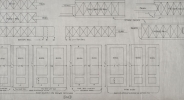

The General Contractor

The Depression Advantage


The General Contractor

The Depression Advantage
About the image
Chicago Daily Tribune, December 6, 1894.
In 1893, the nation fell into an economic depression, but Chicago was experiencing unprecedented growth in jobs and population. Construction costs were down, but building managers struggled to meet leasing goals. Wages were low, and Chicago was a hotbed of labor unrest. Times were tough on labor, and the Marquette construction site was not immune. In May 1894, Aldis stated that “the feeling among men of all kinds about ‘strikes’ is very bad. I have just discharged two men for joining a union—elevator men. I am trying to invent some association of my own, with insurance, etc…. There is only one way to avoid strikes. This is to tie people to you with hooks of steel.”
In September, unionized workers went on strike as non-union men entered the site. Aldis wrote on November 14 that “unions are dissatisfied with the strike and I rather think that all will go well and an agreement be reached…” At the site that same day, a non-union man shot and killed a union vice president. The trouble culminated in December when three men died and many more were wounded in a brawl between the two camps.